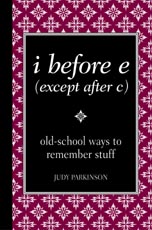 Excerpt
from I Before E (Except After C): Old-School Ways to Remember Stuff
Excerpt
from I Before E (Except After C): Old-School Ways to Remember Stuff
by Judy Parkinson
After learning the alphabet, the next step is to devise coherent
sentences. The rhyme below categorizes each of the parts of speech,
giving a clear example of each grammatical term. The rhyme dates back
to 1855 and was written by educators David B. Tower and Benjamin F.
Tweed:
A NOUN'S the name of any thing;
As, school or garden, hoop, or swing.
ADJECTIVES tell the kind of noun;
As, great, small pretty, white, or brown.
Three of these words we often see
Called ARTICLES -- a, an, and the.
Instead of nouns the PRONOUNS stand;
John's head, his face, my arm, your hand.
VERBS tell of something being done;
As, read, write, spell, sing, jump, or run.
How things are done the ADVERBS tell;
As, slowly, quickly, ill, or well.
They also tell us where and when;
As, here, and there, and now, and then.
A PREPOSITION stands before
A NOUN; as, in, or through, a door.
CONJUNCTIONS sentences unite;
As, kittens scratch and puppies bite.
The INTERJECTION shows surprise
A different rhyme called "The Parts of Speech" is similarly concise as
a reminder of the different components of the English language. The
origin of these verses is unknown.
Every name is called a noun,
As field and fountain, street and town.
In place of noun the pronoun stands, As he and she can clap their hands.
The adjective describes a thing,
As magic wand and bridal ring.
The verb means action, something done --
To read, to write, to jump, to run.
How things are done, the adverbs tell,
As quickly, slowly, badly, well.
The preposition shows relation,
As in the street, or at the station.
Conjunctions join, in many ways,
Sentences, words, or phrase and phrase.
The interjection cries out, "Hark!
I need an exclamation mark!"
Through poetry, we learn how each
Of these make up the Parts of Speech.
What's a Preposition?
To further remember the function of a preposition, insert any word into the following sentence:
The squirrel ran______the tree.
For example, over, under, after, around, through, up, on, to, from, by,
and so forth. Other prepositions include in, at, for, between, among,
and of.
What's a Conjunction?
Conjunctions are words used to join two independent clauses. Most
people are careless with punctuation, especially these days when
shortcuts in e-mails and text messages have become commonplace. But
this FAN BOYS mnemonic helps if you want to remember the coordinating
conjunctions, of which the most important are and, or, and but.
FAN BOYS
For, And, Nor, But, Or, Yet, So
The Rules of Punctuation
Cecil Hartley's poem from Principles of Punctuation or The Art of Pointing (1818) reveals the old-fashioned way that people were advised on how to interpret punctuation when reading sentences out loud.
The stops point out, with truth, the time of pause
A sentence doth require at ev'ry clause.
At ev'ry comma, stop while one you count;
At semicolon, two is the amount;
A colon doth require the time of three;
The period four, as learned men agree.
Though it's not a verse that most grammarians would encourage these
days, it does give you an idea of the difference between each type of
punctuation mark.
On Commas
A cat has claws at the ends of its paws.
A comma's a pause at the end of a clause.
On Colons
The English teacher and prominent lexicographer H.W. Fowler creates a
useful visual image of the job done by the colon, which he says,
"delivers the goods that have been invoiced in the preceding words."
On the Exclamation Point
The following anonymously authored seventeenth-century rhyme appeared in Treatise of Stops, Points, or Pauses, and of Notes Which Are Used in Writing and Print (1680):
This stop denotes our Suddain Admiration,
Of what we Read, or Write, or giv Relation,
And is always cal'd an Exclamation.
The above excerpt is a digitally
scanned reproduction of text from print. Although this excerpt has been
proofread, occasional errors may appear due to the scanning process.
Please refer to the finished book for accuracy.
The above is an excerpt from the book i before e (except after c): old-school ways to remember stuff
by Judy Parkinson
A Reader's Digest book published in association with Michael O'Mara Books Limited. Copyright © Michael O'Mara Books Limited 2008.
